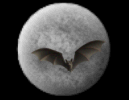
Blackholes2 Forum Message | |
| Forums: |
Atm ·
Astrophotography ·
Blackholes ·
Blackholes2 ·
CCD ·
Celestron ·
Domes ·
Education
Eyepieces · Meade · Misc. · God and Science · SETI · Software · UFO · XEphem |

 |
|
 |
||||
|
|
||||||
Be the first pioneers to continue the Astronomy Discussions at our new Astronomy meeting place... The Space and Astronomy Agora |
| Re: Sorry! Not Possible.
Forum List | Follow Ups | Post Message | Back to Thread Topics | In Response To Posted by RF on July 22, 1998 17:03:06 UTC |
|
The notion of a "symmetrical explosion" only makes sense if one can make classical statements about the particles accelerated by the explosion --- i.e, for all p, n = 1 --> 10-85 or so, pn is here, it's travel this fast, it has this much energy, and it's headed this way. It's impossible to make those statements about elementary particles with arbitrary precision, so some pairs of particles are going to interact when another pair (with the same geometry, velocity, etc.[within the limits of our ability to determine them]) are not, simply because the interactions are probabalistic rather than determinisitic. According to QM, there are limits on how symmetrical the explosion can be. Asymmetries of position, direction, and velocity will quickly develop no matter what the source of the explosion When the universe was one thousandth its present size (roughly 500,000 years after the Big Bang), the density of matter in the region of space that now contains the Milky Way, our home galaxy, was perhaps 0.5% higher than in adjacent regions. Because its density was higher, this region of space expanded more slowly than surrounding regions. As a result of this slower expansion, its relative overdensity grew. When the universe was one hundredth its present size (roughly 15 million years after the Big Bang), our region of space was probably 5% denser than the surrounding regions. This gradual growth continued as the universe expanded. When the universe was one fifth its present size (roughly 1.2 billion years after the Big Bang), our region of space was probably twice as dense as neighboring regions. Cosmologists speculate that the inner portions of our Galaxy (and similar galaxies) were assembled at this time. The stars in the outer regions of our Galaxy were probably assembled in the more recent past. Some cosmologists suspect that some of the objects recently detected by the Hubble Space Telescope may be galaxies in formation. |
|
| Additional Information |
|---|
| About Astronomy Net | Advertise on Astronomy Net | Contact & Comments | Privacy Policy |
|
Unless otherwise specified, web site content Copyright 1994-2025 John Huggins All Rights Reserved Forum posts are Copyright their authors as specified in the heading above the post. "dbHTML," "AstroGuide," "ASTRONOMY.NET" & "VA.NET" are trademarks of John Huggins |